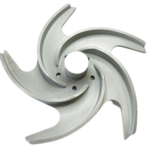




Previous
Next





Process:
01
Mould Making
A mould, known as the Master Die to create wax patterns is made to fit the master pattern by either casting or machining. Technology advancement in tooling and CNC machining has enabled machining a master die from a material such as Steel and Aluminum without the need for a master pattern.
02
Wax Injection
The patterns are then made by injecting or pouring molten wax into the master die and allowing it to harden. Sometimes it’s also used as a coating where inside cavity walls of the die are coated with wax to get a hollow pattern.
For High Dimensional Accuracy, Temperature of the Injection Wax and Pressure of Injection should be coordinate accordingly.
03
Wax Pattern
The wax patterns are then assembled onto a common wax sprue. Sprue is a channel through which molten alloy can reach the mould in an investing ring after the wax has been eliminated. Using heated tools and melted wax, a number of wax patterns can be attached to a central sprue and runner system to create a pattern cluster or a tree
04
Coating
The pattern is then dipped into a slurry of finely ground refractory material and then drained to create a uniform surface coating called a “Prime coat”. High quality Surface Finish Depends on the first coat of this process. Then it will dipped several times into different refractory materials.
05
Drying
This is then left to dry completely, which can take between 16 to 48 hours. Drying can be accelerated by applying a vacuum or minimizing environmental humidity.
06
Dewaxing
Once the refractory material mould has fully dried and cured, they are turned upside down and placed in an oven or special purpose dewaxing Autoclave , where the wax can melt and run out.
This process is totally dependent on the Temperature of the Oven or Autoclaves.
07
Pre Heating
Mould is then pre-heated in preparation for pouring. Preheating allows the metal to stay in the molten state longer so that it can better fill all mould details and increase dimensional accuracy.
08
Pouring
Molten metal up to 3000oC is poured into the hollow mould and then left to cool. When complex, thin sections are involved, mould filling may be assisted by positive air pressure, tilt casting, vacuum casting or centrifugal casting process.
09
Knock Out & Cut Out
After the metal has solidified, techniques such as mechanical chipping, hammering, vibrating used to break the mould and remove the metal casting. Then individual castings are cut away and excess metal is removed. The sprue is cut off and in most cases reused. Cutting is generally done by Gas Cutting Process.
010
Heat Treatment
To improve the Mechanical Properties of the Component Heat treatment will be taken out. Most cases to achieve the required Mechanical Parameters we have to carried out this process.
011
Blasting
Blasting process taken out to remove residues of heat treatment clay and to improve the surface of the casting. In this process media could be change as per the requirement of surface like Sand Blasting, Shot Blasting, Glass bit etc.
012
Final Inspection
After all the processes, First of all Visual inspection will be carried out at the production site.
Then Components will fully checked as per dimensional aspect at Quality Control area. Additional quality check like CMM, Equator, Contourecord and other service will also provide as per customer requirements.
Process Capabilities:
Weight: 0.05 kg – 120 kg
Supply Condition - Raw, finished, assembled or as per customer’s demand
Material: Various grades according to ASTM, AISI, DIN, EN, GOST, JIS and other international standards.
Surface : 3.2 Ra – 6.3 Ra
Tolerances: As per Investment Casting Standards
Production: INDIA
Post Processing: Machining in CNC processing centers and Heat treatment as per the customer’s requirements.
Advantages:
Wide range of material selection
Dimensional Accuracy
Tight Tolerances
Complex Geometry Achievable
Reusability
Low Tooling Cost
If you need more info please contact us!
